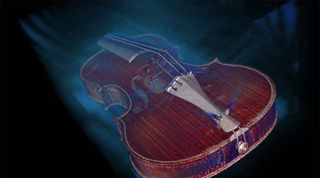Rare Stradivarius Violin Recreated with X-Ray Technology

A precise replica of a Stradivarius violin from 1704, made using X-ray images, may help scientists uncover the secrets of the instrument's unique and highly prized sound quality and also make it available to the average musician.
Currently, it would cost musicians millions of dollars to buy one of the 650 Stradivarius violins in existence today, many of which are kept in museums and rarely, if ever, played. "Betts," the violin that was replicated, is housed in the U.S. Library of Congress in Washington, D.C. It is estimated that Antonio Stradivari, an Italian manufacturer of string instruments who lived from 1644 to 1737, crafted about 1,000 violins.
To better understand what makes Stradivarius violins superior, Steven Sirr, a radiologist at FirstLight Medical Systems in Mora, Minn., teamed up with professional violin makers John Waddle and Steve Rossow of St. Paul, Minn., to scan "Betts" using computed tomography (CT) imaging.
The team hoped to use the images to study the characteristics — including wood thickness, shape and degree of arching — that influence the violin's sound.
"We have two goals: to understand how the violin works and to make reproductions of the world's most prized violins available for young musicians who can't afford an original," Sirr said in a statement.
The more than 1,000 CT scans were converted into stereolithography files and read by a computer numerically controlled (CNC) machine, which Rossow custom-made for the project. The CNC machine is connected to a 3-D precision-carving machine, which then carved out the scroll (the carving at the end of a violin's neck), back and front plates of the violin from various woods. Next, Waddle and Rossow finished, assembled and varnished the replica by hand. [See images of violin replica]
"CT scanning offers a unique method of noninvasively imaging a historical object," Sirr said. "Combined with computer-aided machinery, it also offers us the opportunity to create a reproduction with a high degree of accuracy."
Sign up for the Live Science daily newsletter now
Get the world’s most fascinating discoveries delivered straight to your inbox.
The researchers plan to use the CT images and CNC machine to manufacture affordable replicas of Stradivarius violins in order to make their unique sound available to the general public.
"We believe this process of recreating old and valuable stringed instruments may have a profound influence upon modern string musicians," Sirr said.
The findings regarding the original violin's characteristics and details about how the replica was created were presented Nov. 28 at the annual meeting of the Radiological Society of North America, in Chicago.
You can follow LiveScience writer Remy Melina on Twitter @remymelina. Follow LiveScience for the latest in science news and discoveries on Twitter @livescience and on Facebook.
Most Popular




